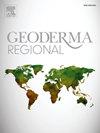芬兰粗质土壤中纸浆和造纸厂废渣的改良价值
IF 3.1
2区 农林科学
Q2 SOIL SCIENCE
引用次数: 0
摘要
作为外源有机物的一种来源,纸浆和/或造纸厂污泥(PPMS)可能会对作物产量以及土壤化学和物理特性产生有益的影响。本研究的目的是在芬兰中东部的淤泥质壤土上进行为期三年的田间试验,评估两种不同的 PPMS 材料对作物产量、渗水质量以及土壤化学性质和水力性质的影响。春季在大麦下播种禾本科牧草作为覆盖作物之前,以 21-28 新鲜毫克/公顷-1 的比例施用新鲜(FPMS)和石灰稳定(LPMS)淤泥,并将其掺入上层 7 厘米的土层中。补充氮(N)的施用量为 40 和 80 千克/公顷。在施氮量为 40 千克/公顷时,大麦因氮固定而减产,但标准施氮量(80 千克/公顷)和适度的碳氮比(FPMS 27:1,LPMS 24:1)足以避免大幅减产。施用 PPMS 后的第二年和第三年,对禾本科牧草干物质总产量的残留影响趋于积极,这可能是由于污泥-氮的矿化速度较慢。与未施用 LPMS 的对照组相比,施用 LPMS 后表层土壤的 pH 值提高了 0.5-0.7 个单位,土壤中的钙浓度提高了 240-660 毫克/升。在施用 PPMS 的当年,与未施用改良剂的土壤相比,最上层 10 厘米土壤中的总碳(C)浓度显著增加(约 2.0 g kg-1)。在接下来的几年中,土壤中 C 的变化已无法测量,这表明污泥-C 的分解速度相对较快。经 PPMS 处理过的土壤的饱和导水率往往比未经改良的土壤高 1.4 到 2.3 倍。除植物可利用水量下降外,其他常见的保水参数并未受到 PPMS 改良剂的显著影响。处理对-13 和-316 kPa matric电位之间的保水量有明显的积极影响,这表明土壤中有助于储水的中等大小孔隙有所增加。为了保持或增强 PPMS 对作物产量和土壤理化性质的直接和间接有益影响,需要重复施用 PPMS,可能的话结合使用有机肥料,尤其是在草地韭菜生长的年份。本文章由计算机程序翻译,如有差异,请以英文原文为准。
The amendment value of pulp and paper mill sludges in Finnish coarse-textured soil
As a source of exogenous organic matter, pulp and/or paper mill sludges (PPMS) may have beneficial effects on crop productivity and soil chemical and physical properties. This study's aim was to assess the impacts of two different PPMS materials on crop yields, the quality of percolation water, and soil chemical and hydraulic properties in a three-year field experiment on a silt loam soil in East Central Finland. Fresh (FPMS) and lime-stabilized (LPMS) sludges were applied once at rates of 21–28 fresh-Mg ha−1 in the spring prior to the sowing of grass ley under barley as a cover crop and incorporated into the upper 7 cm soil layer. Supplemental nitrogen (N) was applied at levels of 40 and 80 kg ha−1. A decrease of barley grain yield due to N immobilization was observed at the N level 40 kg ha−1, but the standard N application rate (80 kg ha−1) connected with a moderate C:N ratio (FPMS 27:1, LPMS 24:1) was adequate to avoid significant yield losses. In the second and third year following the PPMS applications, there was a tendency for positive residual effects on the total dry matter yield of grass ley, which could be attributed to slow mineralization of sludge-N. The application of LPMS increased the pH in surface soil by 0.5–0.7-units and Ca concentration by 240–660 mg L−1 of soil relative to the non-amended control over the study period. In the year of PPMS applications, the amendments produced a significant increase (about 2.0 g kg−1) in the total carbon (C) concentrations in the uppermost 10 cm soil layer relative to the non-amended soil. During the following years, the change in soil C was no longer measurable, indicating relatively fast decomposition of sludge-C. Saturated hydraulic conductivity tended to be 1.4 to 2.3 times higher in the PPMS-treated soils than in the non-amended soil. Except for the decline in readily plant-available water, the other common water retention parameters were not significantly affected by the PPMS amendments. There were significant positive treatment effects on the amount of water retained between −13 and − 316 kPa matric potentials, suggesting an increase in medium-sized pores contributing to water storage in the soil. To maintain or enhance the beneficial direct and indirect effects of PPMS on crop yields and soil physico-chemical properties, repeated applications of PPMS are required, possibly combined with the use of organic fertilizers, especially during grass ley years.
求助全文
通过发布文献求助,成功后即可免费获取论文全文。
去求助
来源期刊

Geoderma Regional
Agricultural and Biological Sciences-Soil Science
CiteScore
6.10
自引率
7.30%
发文量
122
审稿时长
76 days
期刊介绍:
Global issues require studies and solutions on national and regional levels. Geoderma Regional focuses on studies that increase understanding and advance our scientific knowledge of soils in all regions of the world. The journal embraces every aspect of soil science and welcomes reviews of regional progress.
 求助内容:
求助内容: 应助结果提醒方式:
应助结果提醒方式:


